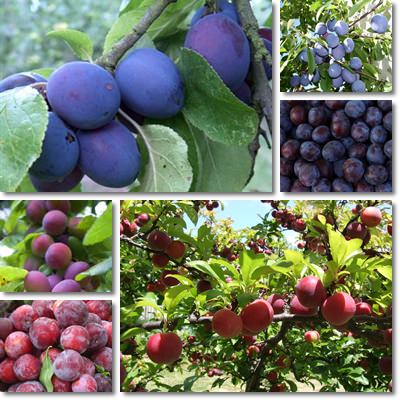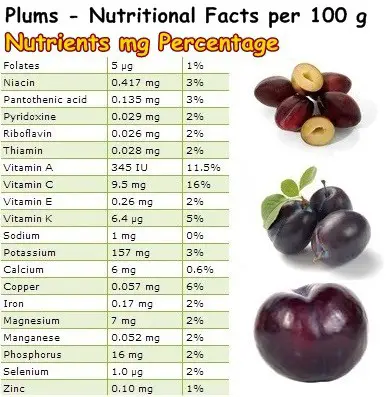Today I am going to talk to you about another summer delight, the delicious and highly nutritious plum. The plum (Prunus domestica) is a majestic-looking fruit with a considerable number of health benefits. Plums belong to the Prunus genus and are distant relatives of peaches and nectarines. From a botanical point of view, they are considered drupes, fruits whose seeds are protected by a hardened shell.
The plum tree is said to have been domesticated so long ago that its traces are lost in time. Historians believe however that the plum tree can be traced back as far as the Neolithic age. Although there are numerous plum species, approximately 100, only the European and the Japanese plum are commercialized worldwide.
What do plums look and taste like?
Unripe plums are typically a lighter green color and have a firm, but crisp pulp. The unripe fruit have a sharp, sour taste and an astringent flavor. Just like sapodilla, some plums can give you a dry mouth sensation. When ripe, plums may vary in color from green (in Greengage plums) and red (the Victoria cultivar) to yellow (Yellow Gage plums) and purple or dark-purple (Damson plums).
Many people think cherry plums (also called myrobalan plums) are also a variety of regular plums, however they are an entirely different fruit.

Most plum varieties are sweet and juicy when ripe, with a firm but succulent flesh. The riper the plum, the softer the flesh. You can tell a plum is overripe if it becomes too soft to the touch, developing a mushy flavor and a spoilt fruity, slightly spirituous taste. Ripe plums should have a pleasant taste and flavor and are ideally extremely sweet with delicious fruity flavors and a delicate perfume.
You can say they have a unique flavor profile, which is why they are a preferred choice for some of the most refined dishes. However, some varieties may have a more tart flavor and chewy skin even when ripe. Both ripe and unripe plums have their own set of nutritious elements, from essential vitamins and minerals to powerful antioxidants.
What are the benefits of Plums?
Whether they are fresh or dry, plums are well known for their amazing health benefits. For example, studies show that regular consumption of the fruit increases the absorption of iron due to the presence of considerable amounts of vitamin C. There are two types of iron in our food: heme iron in meat products and non-heme iron in plant sources.
The iron in meat products is often much more bioavailable and readily absorbed, however, non-heme iron from plant sources can be taken up just as well by increasing our vitamin C intake. And this can be done easily by eating a few plums. Unripe plums which are so sour-tasting they make you pucker up from the astringency, are an even better source of vitamin C for iron absorption than the ripe fruit.
Moreover, plums contain small amounts of tryptophan, an essential amino acid that our body converts to serotonin, a neurotransmitter essentially responsible for feelings of happiness. Tryptophan further helps synthesize melatonin, a hormone that helps you sleep as well as makes it possible for the body to make vitamin B3 which is essential for brain and nervous system health. The amino acid tryptophan also plays an important role in protein synthesis.
Overall, even though plums may not provide as much of the amino acid as a serving of turkey or chicken, they do have varied nutritional benefits.

Plums are an overall good source of vitamins A and K as well. While vitamin A contributes to good immunity and eye heath, vitamin K supports blood coagulation and helps prevent easy nosebleeds or bruising. Plums contain small amounts of almost every essential vitamin and dietary mineral, 11.5 g of carbohydrates and 9 g of natural sugars for every 100 g of fresh fruit which makes them a great tonic which naturally elevates energy levels.
In addition to this, both fresh and dried plums (or prunes) are rich in dietary fiber indigestible plant material that passes unchanged through the intestinal tract.
Fresh plums contain about 1.4 g of dietary fiber for every 100 g. The skin of the fruit in particular is rich in fiber. Overall, eating both the fresh and dried fruit helps reduce LDL (bad) cholesterol by regulating intestinal absorption of fats from food.
A healthy fiber intake is also known to relieve constipation, benefit hemorrhoids (read more about what foods to eat for hemorrhoids) and exert a protective effect on the colon lining by reducing its exposure to toxins from stools.
Chlorogenic and neochlorogenic acid are two phytochemicals found both in fresh and dry plums. They are basically naturally-occurring antioxidants with wonderful health properties, capable of destroying an infamous free radical called superoxide anion and preventing its damaging effects on cell tissues. Free radicals are harmful molecules that damage cells and DNA and cause disruptions in normal cell functions that could lead to degenerative diseases and cancer.
Antioxidants combat the effects of free radicals and some even reverse existing damage, hence the importance of including fresh fruits, vegetables and spices into our diets. Dry plums, made from sun-drying the fresh fruits, have been shown to have a higher antioxidant content than blueberries which is why they have been the focus of numerous important research papers.

If you look closely at the nutritional table above you will notice that plums contain small quantities of basically every important vitamin and mineral: from B-group vitamins to vitamins C, A, K and E and trace amounts of magnesium, potassium, phosphorous, manganese, zinc, iron and calcium. Any food that can provide you with essential nutrients, even in small amounts, is a valuable addition to your diet because it helps you meet your nutritional requirements so you can enjoy better health.
Overall, plums are a delicious source of phytochemicals, vitamins and minerals with strong antioxidant effects and benefits on the digestive, cardiovascular, nervous and immune system as well as energy metabolism. When they are in season, which is from roughly May to October, it is best to consume them fresh so you can enjoy their unique, fruity-sweet flavor. In winter, dry plums are perfect to satisfy your sweet cravings while providing you with concentrated amounts of minerals.
Short list of plum benefits
Overall, eating plums as often as you can provides you with the following health benefits:
- Good for eyesight and skin thanks to a good vitamin A content.
- Boosts immunity as a result of being a good source of vitamins A and C.
- Provides antioxidant benefits from vitamins A, C, E, copper and various phytochemical antioxidants.
- Tonic, energizing effect and combats fatigue.
- Source of dietary fiber, relieves constipation and promotes colon health.
- Anti-inflammatory properties from vitamins, minerals and antioxidants.
- Contributes to better mood and better sleep.
- Small amounts of calcium, phosphorus and magnesium for stronger bones.
Interesting plum facts
People have even turned plums into strong alcoholic beverages such as slivovitz (in Serbia), palinka (in Hungary) or pălincă (in Romania). Traditional plum jams of a pasty consistency called plum butter or plum stew are also highly appreciated in Southeast Europe where they are used as filling for pancakes, gogoși (the Romanian version of doughnuts) or as a sandwich spread. Even cooked, plums preserve some benefits. For example, plum jam remains a great source of dietary fiber and provides benefits for digestion, transit and constipation.
